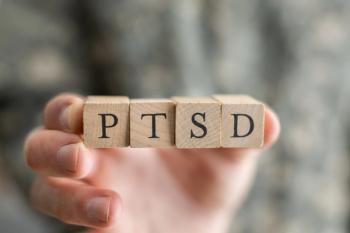
- Psychiatric Times Vol 20 No 4
- Volume 20
- Issue 4
Secondary Traumatization in Mental Health Care Providers
What is secondary traumatization? The authors discuss current research and implications for this controversial and emerging field of study.
Mental health care professionals specializing in the treatment of trauma hear tales of extreme human suffering and observe the emotions of fear, helplessness and horror registered by survivors on a consistent basis. Recent research demonstrates that these occupational duties may cause psychological symptoms in the practitioner who bears witness to the survivors' account of trauma.
Primary posttraumatic stress disorder may be diagnosed in an individual who experienced, witnessed or was confronted with a traumatic event and responded with intense fear, helplessness or horror. Intentional traumas (e.g., combat, sexual assault, terrorism and mass violence), as well as unintentional traumas (e.g., natural disasters, accidents), may cause this pervasive psychiatric condition.
Secondary trauma is defined as indirect exposure to trauma through a firsthand account or narrative of a traumatic event. The vivid recounting of trauma by the survivor and the clinician's subsequent cognitive or emotional representation of that event may result in a set of symptoms and reactions that parallel PTSD (e.g., re-experiencing, avoidance and hyperarousal). Secondary traumatization is also referred to as compassion fatigue (Figley, 1995) and vicarious traumatization (Pearlman and Saakvitne, 1995).
Secondary trauma is an understudied and controversial clinical phenomenon. In this article we will explore the controversy, review the existing literature, describe the personal and professional consequences, and address prevention of secondary traumatization.
The Controversy
Detractors of the secondary traumatization phenomenon in health care professionals claim that labeling clinicians with secondary PTSD is pathologizing and best described as a reaction, not a disorder. Just as most individuals directly exposed to a traumatic stressor exhibit some PTSD symptoms that abate quickly over time, many clinicians will have transitory reactions to survivor narratives. Yet in both primary and secondary trauma exposure, a small percentage of individuals will develop the full psychiatric disorder.
Research findings of primary and secondary PTSD related to the World Trade Center terrorist attacks illustrate this point. Galea and colleagues (2002) showed that in the first five to six weeks following the Sept. 11, 2001, terrorist attacks in New York City, 20% of residents living close to the World Trade Center met criteria for probable PTSD. Thus, the majority of individuals directly exposed to the terrorist attacks in New York City did not meet criteria for PTSD.
Research on secondary traumatization shows a similar prevalence pattern in mental health care professionals who treated survivors of the World Trade Center collapse (Gulliver et al., 2002). On standardized clinical interviews, many providers endorsed symptoms of PTSD linked to their exposure to survivor narratives, but most did not meet diagnostic criteria for PTSD. However, a minority of professionals met full diagnostic criteria for PTSD in the months following their exposure to survivor narratives.
A second controversial point concerns whether the PTSD DSM-IV Criterion A can include indirect exposure to a trauma. However, the definition of a traumatic stressor can be ambiguous. In fact, PTSD can occur in individuals who have been exposed indirectly to a traumatic stressor. For example, Weisaeth (1989) found PTSD in workers who were not present at the time of an industrial explosion at their workplace. More recently, Schlenger et al. (2002) reported that indirect exposure to the Sept. 11 disaster via the number of hours of television coverage watched per day on and after Sept. 11 was significantly associated with probable PTSD in individuals living outside of the terrorist attack sites. These findings show that the parameters of the Criterion A event which can precipitate PTSD are still evolving.
Review of the Literature
The current state of empirical literature on secondary traumatization among health care professionals is in its infancy. Although theorists such as Figley (1995), McCann and Pearlman (1990), and Stamm (1995) have written extensively on the phenomena of secondary traumatization, the level of corroborative data is not commensurate with the sophistication of existing theories. A recent review of Psychlit journal articles found only 17 peer-reviewed articles on secondary traumatization. Of these, only 12 contained data, and the majority of these were descriptive (qualitative) in nature.
The descriptive studies on secondary traumatization can be categorized as measure development (e.g., Jenkins and Baird, 2002; Motta et al., 2001), predictive variable studies (e.g., Adams et al., 2001; Schauben and Frazier, 1995; Wasco and Campbell, 2002) and one meta-analysis that indirectly evaluated techniques to prevent or treat secondary trauma (Everly et al., 1999).
The second category of studies explores secondary traumatization as a function of occupational roles and examines the variables that correlate with the development of symptoms. Eight studies describe the phenomena of secondary trauma among counselors with diverse training, caseloads, degrees and socioeconomic status (Adams et al., 2001; Ghahramanlou and Brodbeck, 2000; Everly et al., 1999; Iliffe and Steed, 2000; Jenkins and Baird, 2002; Schauben and Frazier, 1995; Steed and Bicknell, 2001; Wasco and Campbell, 2002). All eight studies describe a stable set of symptoms analogous to PTSD, yet a very low incidence of meeting clinical criteria (range between studies: 0% to 4%) or impairment in occupational roles was reported. This result is difficult to interpret, as the current status of the psychometric utility of available instruments decreases confidence in any conclusion, and each study used a different set of assessments. In sum, trauma counselors are likely to report some negative consequences of their work that maps onto a PTSD typology. What remains to be seen is how often this symptom profile is clinically significant and how symptoms affect patient care.
This same set of studies yields contradictory evidence about correlates of secondary trauma symptoms. The most frequently studied correlate is the therapist's personal trauma history. Jenkins and Baird (2002) found that personal trauma history correlated with secondary trauma symptoms, but Schauben and Frazier (1995) and Adams et al. (2001) did not. In addition, Schauben and Frazier found that the greater the percentage of survivors in a provider's caseload, the greater the number of secondary trauma symptoms reported.
Other factors suggested by theorists as potentially predictive of secondary traumatization include insufficient training, identification with the victims, insufficient support in the workplace, and insufficient social and familial support. Future research to further assess these characteristics is recommended.
Assessment
There are three self-report inventories that can measure secondary trauma: the Compassion Fatigue Self-Test (CFST) for Psychotherapists (Figley, 1995), the TSI Belief Scale (TSI-BLS) (Pearlman, 1996) and the Secondary Trauma Questionnaire (STQ) (Motta et al., 2001). These inventories vary by their domain of study and targeted population. While the CFST and STQ items more closely measure trauma exposure and PTSD symptomatology, the TSI-BLS measures changes in cognitive schemas (e.g., safety, trust, esteem, intimacy and control) consistent with the author's theoretical conceptualization of vicarious traumatization. The CFST and TSI-BSL were developed to assess secondary trauma in therapists whereas the STQ was designed for both therapists and the general population.
Standardized clinical interviews specific to secondary traumatization have not been developed. However, Gulliver et al. (2002) used the Clinician Administered PTSD Scale (CAPS) in their study of secondary trauma in disaster relief clinicians. World Trade Center survivor narratives heard by the clinicians were coded as the Criterion A event and the CAPS questions were administered as it would be for primary PTSD.
A recent validational study of the CFST and TSI-BSL self-report mea-sures showed convergent validity between the CFST and TSI-BSL, moderate convergence with burnout, and strong convergence with general distress (Jenkins and Baird, 2002). The next level of measure development will likely provide norms and cutoffs for symptom intensity, that will strengthen current assessment methodology.
Clinical Consequences
If trauma is contagious (Herman, 1992) and the effects of treating trauma survivors may parallel those of primary trauma, a clinician's work with patients may be adversely affected. Herman (1992) suggested that the effects on therapists may include disruptions in the therapeutic alliance, conflict with professional colleagues attempts to rescue or control patients, and violations of therapeutic boundaries.
Therapists overwhelmed by traumatic material may begin to avoid or deny their patient's experiences (Baranowsky, 2002). Alternatively, they might push patients too quickly in an effort to master their own responses. The schematic disruptions associated with vicarious traumatization (Pearlman and Saakvitne, 1995) could also impact clinical work. A clinician whose views of trust and safety have been undermined might be unable to respond effectively to traumatized patients. Researchers interviewing trauma survivors might also introduce bias into studies in their efforts to control their own exposure to trauma material. The recognition of secondary effects requires that we further investigate the implications for practitioners because we cannot assume that the practitioners' responses will not impact the care they provide.
Prevention
The key components of secondary trauma prevention might be found within practice systems (Herman, 1992). Echoing this sentiment, Pearlman and Saakvitne (1995) stated that four domains are important to the prevention of secondary traumatization in mental health care providers: 1) professional strategies, such as balancing caseloads and accessible supervision; 2) organizational strategies, such as sufficient release time and safe physical space; 3) personal strategies, such as respecting one's own limits and maintaining time for self-care activities and 4) general coping strategies, such as self-nurturing and seeking connection. Thus far, no studies have evaluated the effectiveness of these prevention strategies.
Training Implications
The empirical evidence indicating secondary effects in practitioners raises the immediate question of how this should be incorporated into clinician training. We have a duty to educate those entering the field to anticipate how the work will affect them and to prepare them to address these effects (Munroe, 1995).
Although secondary traumatization may adversely affect practitioners and the services they deliver, work with trauma survivors can also be immensely rewarding and has the potential to allow practitioners to grow personally and enhance their compassion, provided responses to this difficult work are used constructively.
Conclusions
Treatment of posttraumatic psychological reactions in civilians became a significant public health concern in the United States after Sept. 11. This public priority should also extend to the emotional well-being of clinicians who are exposed to traumatic stimuli in their occupational duties. Just as ongoing national policy discussions explicitly recommend that health care professionals and other first responders be vaccinated in the event of bioterrorist attacks, similar consideration should be made with first-line trauma and disaster relief clinicians. If clinicians are to maintain pace with the mental health care needs of U.S. citizens living in an increasingly dangerous world then their psychological well-being must also be recognized and protected.
References:
References
1.
Adams KB, Matto HC, Harrington D (2001), The Traumatic Stress Institute Belief Scale as a measure of vicarious trauma in a national sample of clinical social workers. Families in Society: The Journal of Contemporary Human Services 82(4):363-371.
2.
Baranowsky AB (2002), The silencing response in clinical practice: on the road to dialogue. In: Treating Compassion Fatigue, Figley CR, ed. New York: Brunner-Routledge.
3.
Everly GS, Boyle SH, Lating JM (1999), The effectiveness of psychological debriefing with vicarious trauma: a meta-analysis. Stress Medicine 15(4):229-233.
4.
Figley CR (1995), Compassion fatigue as secondary traumatic stress disorder: an overview. In: Compassion Fatigue: Coping with Secondary Traumatic Stress Disorder in Those Who Treat the Traumatized, Figley CR, ed. New York: Brunner/Mazel.
5.
Galea S, Ahern J, Resnick H et al. (2002), Psychological sequelae of the September 11 terrorist attacks in New York City. N Engl J Med 346(13):982-987 [see comments].
6.
Ghahramanlou M, Brodbeck C (2000), Predictors of secondary trauma in sexual assault trauma counselors. Int J Emerg Ment Health 2(4): 229-240.
7.
Gulliver SB, Knight J, Munroe J et al. (2002), Secondary trauma in disaster relief clinicians at ground zero. Presented at the 18th Annual Meeting of the International Society for Traumatic Stress Studies. Baltimore; Nov. 9.
8.
Herman JL (1992), Trauma and Recovery: The Aftermath of Violence from Domestic Abuse to Political Terror. New York: Basic Books.
9.
Iliffe G, Steed LG (2000), Exploring the counselor's experience of working with perpetrators and survivors of domestic violence. J of Interpersonal Violence 15(4):393-412.
10.
Jenkins SR, Baird S (2002), Secondary traumatic stress and vicarious trauma: a validational study. J Trauma Stress 15(5):423-432.
11.
McCann IL, Pearlman LA (1990), Vicarious traumatization: a framework for understanding the psychological effects of working with victims. J Trauma Stress 3(1):131-149.
12.
Motta RW, Hafeez S, Sciancalepore R, Diaz AB (2001), Discriminant validation of the Modified Secondary Trauma Questionnaire. Journal of Psychotherapy in Independent Practice 2(4):17-25.
13.
Munroe JF (1995), Ethical issues associated with secondary trauma in therapists. In: Secondary Traumatic Stress: Self-Care Issues for Clinicians, Researchers, and Educators, Stamm BH ed. Lutherville, Md.: Sidran Press, pp211-229.
14.
Pearlman LA (1996), Psychometric review of TSI Belief Scale Revision L. In: Measurement of Stress, Trauma and Adaptation, Stamm BH, ed. Lutherville, Md.: Sidran Press.
15.
Pearlman LA, Saakvitne KW (1995), Trauma and the Therapist: Countertransference and Vicarious Traumatization in Psychotherapy with Incest Survivors. New York: W.W. Norton.
16.
Schauben LJ, Frazier PA (1995), Vicarious trauma: the effects on female counselors of working with sexual violence survivors. Psychology of Women Quarterly 19(1):49-64.
17.
Schlenger WE, Caddell JM, Ebert L et al. (2002), Psychological reactions to terrorist attacks: findings from the national study of Americans' reactions to September 11. JAMA 288 (5):581-588 [see comment].
18.
Stamm BH (ed.) (1995), Secondary Traumatic Stress: Self-Care Issues for Clinicians, Researchers, and Educators. Lutherville, Md.: Sidran Press.
19.
Steed L, Bicknell J (2001), Trauma and the therapist: the experience of therapists working with the perpetrators of sexual abuse. The Australasian Journal of Disaster and Trauma Studies 2001 (1):1-9.
20.
Wasco SM, Campbell R (2002), Emotional reactions of rape victim advocates: a multiple case study of anger and fear. Psychology of Women Quarterly 26(2):120-130.
21.
Weisaeth L (1989), The stressors and the post-traumatic stress syndrome after an industrial disaster. Acta Psychiatr Scand 355(suppl):25-37.
Articles in this issue
over 22 years ago
Global and Social Considerationsover 22 years ago
Security Alerts Trouble American Psycheover 22 years ago
Psychiatry's Hottest Niche Marketsover 22 years ago
First Night On-Call, Coronary Care Unitover 22 years ago
The Last Frontier: Going Beyond the Limitsover 22 years ago
Changes in the Concept of PTSD and Traumaover 22 years ago
The DSM: Not Perfect, but Better Than the Alternativeover 22 years ago
Dump the DSM>!Newsletter
Receive trusted psychiatric news, expert analysis, and clinical insights — subscribe today to support your practice and your patients.




